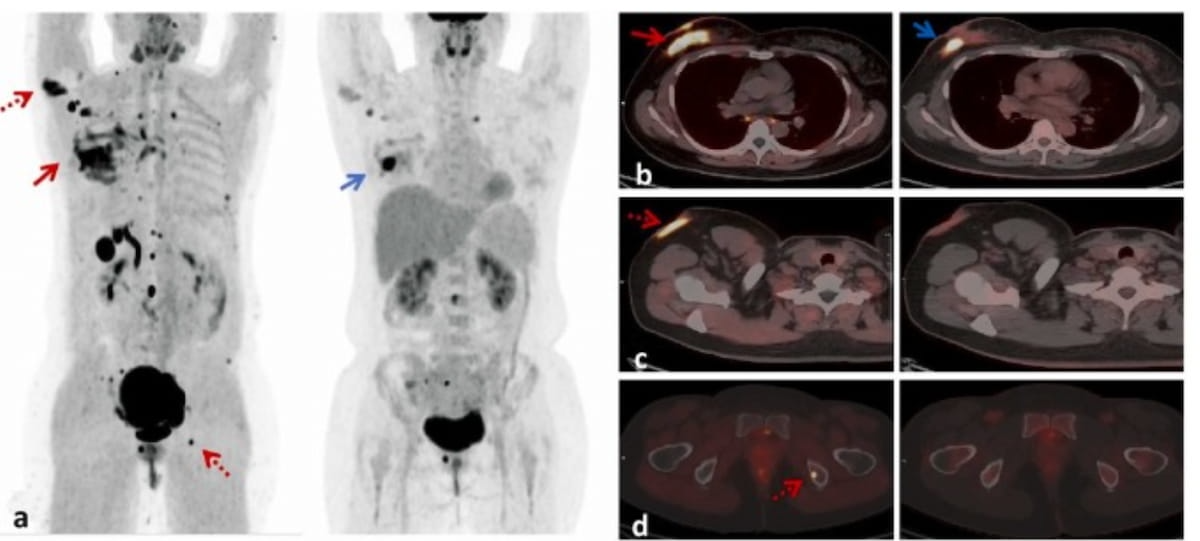Emerging research suggests that 18F-FAPI PET/CT may lead to a significantly higher rate of upstaging for newly diagnosed breast cancer in contrast to 18F-FDG PET/CT.
For the retrospective study, recently published in Academic Radiology, researchers compared the upstaging rate as well as the sensitivity of the two imaging agents for axillary and extraaxillary regional lymph node metastases (URNM) and distant metastases in 38 patients (average age of 52.2) who had initial IIB or IIIC breast cancer.
The study findings revealed that 18F-FAPI PET/CT had a 13.2 percent higher overall upstaging rate than 18F-FDG PET/CT (47.4 percent vs. 34.2 percent). Based on a lesion-based analysis, the researchers found that 18F-FAPI PET/CT had a 97.6 percent sensitivity rate for URNM in comparison to 52.4 percent for 18F-FDG PET/CT. The study authors also noted over a 30 percent higher sensitivity rate for distant metastases with 18F-FAPI PET/CT in contrast to 18F-FDG PET/CT (98.1 percent vs. 67.3 percent).
While the patient-based analysis revealed no statistically significant difference between the PET/CT agents in sensitivity for distant metastases, 18F-FAPI PET/CT maintained a significantly higher sensitivity for URNM over 18F-FDG PET/CT (100 percent vs. 53.8 percent), according to the study authors.
“These results indicate that 18F-FAPI has high patient-based and lesion-based yield in systemic staging of breast cancer, and thus seems to have the potential to replace 18F-FDG, which is currently regarded as the standard of care,” wrote lead study author Ji Bin, M.D., who is affiliated with the Department of Nuclear Medicine at the China-Japan Union Hospital of Jilin University in Changchun, China, and colleagues.
While research has demonstrated the value of 18F-FDG PET/CT in the staging and management of patients with newly diagnosed breast cancer, the study authors maintained that the agent offers suboptimal detection in cases of micro-metastasis and limited FDG uptake in histopathological types of breast cancer including HER2-positive cases and lobular cancer.
Alternately, the study authors said that FAP PET offers higher sensitivity for smaller malignancies and the agent’s capability to target tumor stroma provides more robust uptake in all types of breast cancer.
“Hence, FAPI PET may overcome the limitations of conventional FDG PET and more accurately show the existence or the extent of metastatic disease in systemic staging of breast cancer,” emphasized Bin and colleagues.
Three Key Takeaways
1. Higher upstaging rate. 18F-FAPI PET/CT demonstrated a 13.2 percent higher upstaging rate compared to 18F-FDG PET/CT in newly diagnosed breast cancer patients, indicating better detection of advanced disease stages.
2. Superior sensitivity for lymph node metastases. 18F-FAPI PET/CT exhibited significantly higher sensitivity for detecting axillary and extraaxillary regional lymph node metastases (URNM), with a sensitivity rate of 97.6 percent compared to 52.4 percent for 18F-FDG PET/CT.
3. Better detection of distant metastases. The per-lesion analysis showed that 18F-FAPI PET/CT had over 30 percent higher sensitivity for detecting distant metastases compared to 18F-FDG PET/CT (98.1 percent vs. 67.3 percent), potentially leading to more accurate staging and treatment decisions.
The researchers added that the higher lesion-based sensitivity of 18F-FAPI PET/CT may bolster accuracy with respect to the number of detected metastatic lesions and corresponding treatment decisions.
“This could be of significant clinical implications as local ablative therapeutic approaches such as metastatectomy and stereotactic body radiation therapy have accumulated abundant evidence to support their use in oligometastatic disease,” noted Bin and colleagues. “With a higher sensitivity, 18F-FAPI may more confidently ensure a true oligometastatic disease status and thus serve as a better tool to select patients who could benefit from these locally aggressive therapies and have prolonged survival.”
(Editor’s note: For related content, see “SNMMI: New Study Suggests Merits of FAPI PET/CT for Breast Cancer Staging,” “PET/CT Shows Superior Results for Detecting Oligometastatic Breast Cancer in Comparison to CT” and “PET Imaging Study Suggests Possible Chemotherapy-Free Pathway for Treating Early Breast Cancer.”)
Beyond the inherent limitations of a single-center retrospective study, the authors conceded a small sample size and a lack of information on true-negative findings for metastatic disease with the use of 18F-FAPI PET/CT.
